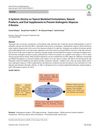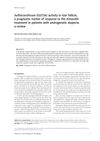Those that apply minoxidil twice a day Chat 4/20/2025
Minoxidil is typically applied once daily, with some users opting for foam to minimize irritation. Users often combine it with finasteride or use oral minoxidil for improved results, while managing scalp irritation with ketoconazole or salicylic acid shampoos.
View this post in the Community →
Similar Community Posts Join
5 / 1000+ resultscommunity You should start with finasteride only
Begin with finasteride to evaluate its effectiveness before adding minoxidil. Combining treatments may enhance results but could also increase side effects; individual responses differ.
community Am i too obsessed with hair loss prevention? And Is This obsession healty? Am i the only one? Look at my collection In This picture: Oral finasteride/ topical finasteride/ minoxidil 5% + tretinoin/ minoxidil 5%/ Alfatradiol 0.025%/Stemoxydine 5%/ dermapen/ketoconazole 1%/viviscal/procyanidin B2.
User obsessed with hair loss prevention shares collection of treatments, including oral and topical finasteride, minoxidil, dermapen, and more. Others suggest adding RU58841, laser helmet, and PRP, while some advise dropping certain treatments for long-term manageability.
community Should I start minoxidil before finasteride?
A 21-year-old male from Bangladesh is experiencing hair loss and was advised by a dermatologist to use ketoconazole shampoo, anti-fungal treatments, biotin, and 5% minoxidil, with finasteride to be considered after six months. The user is unsure whether to follow this advice or start finasteride immediately alongside minoxidil.
community 10months on minoxidil as an “ok responder”
The user added topical minoxidil to their finasteride regimen, resulting in healthier hair and some regrowth, especially after quitting nicotine. They experienced minimal shedding and noted improvements in hairline density, finding the treatment mostly preventative.

community Can I still save my hairline at age of 15?
A 15-year-old is concerned about hair loss, possibly at Norwood 2 or 3, and is using shampoos and conditioners recommended by a trichologist. Suggestions include considering topical minoxidil and consulting a doctor about topical anti-DHT treatments like finasteride or RU58841, but avoiding 5-alpha-reductase inhibitors at this age.
Related Research
6 / 1000+ results
research A Systematic Review on Topical Marketed Formulations, Natural Products, and Oral Supplements to Prevent Androgenic Alopecia
Various treatments, including FDA-approved drugs, natural products, and oral supplements, can help with hair loss, but a patient's medical history and potential allergies should be considered when choosing a treatment.

research Sulfotransferase SULT1A1 Activity in Hair Follicle: A Prognostic Marker of Response to Minoxidil Treatment in Androgenetic Alopecia
Sulfotransferase SULT1A1 activity may predict minoxidil treatment success for hair loss.

research Current Trends in Hair Care in Men
Proper hair care and suitable products are essential for men's scalp health and well-being.

research Research Progress in the Treatment of Non-Scarring Alopecia: Mechanism and Treatment
New treatments are needed for non-scarring alopecia due to current limitations.
research Common Hair Problems: Dandruff and Androgenetic Alopecia

research Compounding as a Current Therapeutic Option in Dermatology
Customized medications made through compounding can be beneficial for various skin conditions but require careful regulation and collaboration between doctors and pharmacists.